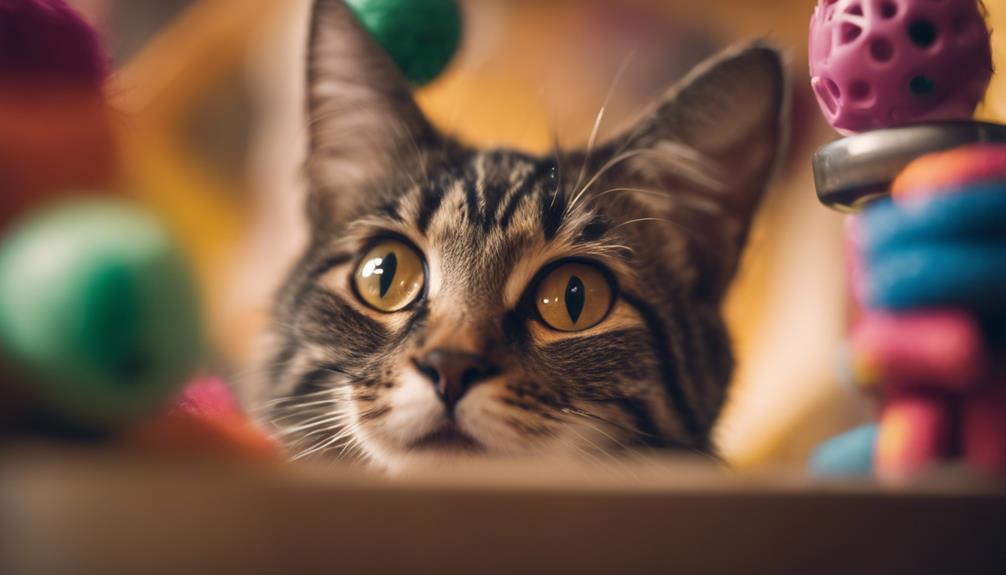What Are the Best Socialization Techniques for Shy or Timid Cats?

Creating a safe environment involves providing hiding spots, vertical spaces, and quiet areas for the cat to feel secure. Slowly introducing new people, animals, or environments can also help the cat feel more comfortable and less anxious. Positive reinforcement training, such as using treats or favorite toys, can encourage the cat to associate social interactions with positive experiences. Over time, with patience and consistency, shy or timid cats can learn to trust and engage with others more confidently.
Understanding Your Cat's Behavior
Understanding your cat's behavior is crucial in determining the best socialization techniques for shy cats. Cats communicate a lot through their body language. When a cat feels anxious or scared, they may exhibit signs like flattened ears, dilated pupils, or a tucked tail. On the other hand, a relaxed and confident cat will have their ears upright, normal-sized pupils, and a gently swaying tail. By observing these cues, you can better understand your cat's feelings and tailor your approach accordingly.
Building confidence through play is a wonderful way to socialize shy cats. Interactive toys like feather wands or laser pointers can engage your cat's natural instincts and provide mental stimulation. Through play, shy cats can gain confidence, reduce stress, and develop trust with their humans. It's essential to start slowly, allowing the cat to initiate interactions and gradually increasing the playtime as they become more comfortable. By incorporating play into your cat's routine, you can help them feel more secure and open to socializing.
Creating a Safe Environment

Creating a safe environment is crucial when socializing shy cats. Providing safe hiding spots allows them to retreat when feeling overwhelmed, giving them a sense of security.
Using a slow introduction method can help build trust and comfort between the cat and their human or other pets.
Safe Hiding Spots
Incorporating cozy hiding spots throughout the living space can provide shy cats with a sense of security and comfort, helping them acclimate to their surroundings at their own pace.
Creating comforting spaces and quiet retreats like cozy nooks and secure havens allows timid cats to have a safe environment where they can observe without feeling exposed.
Placing these hiding spots strategically in different areas of the house gives shy cats options to retreat when they feel overwhelmed, reducing their stress levels.
By offering these secure hiding spots, caregivers can help their shy feline companions build confidence gradually, knowing they've a safe place to retreat to whenever they feel the need.
This thoughtful approach can significantly aid in the socialization process of shy or timid cats.
Slow Introduction Method
When introducing a shy cat to a new environment, gradually acclimating them to their surroundings is crucial for building trust and confidence. Desensitization training and behavior modification techniques can help ease the cat into unfamiliar situations.
It's essential to create a safe space where the cat feels secure and can retreat if needed. Confidence building exercises, such as interactive play sessions and socialization games, can boost the cat's self-assurance over time.
Providing positive reinforcement and patience are key components of the slow introduction method. By allowing the cat to adjust at their own pace and offering support along the way, caregivers can help shy cats become more comfortable and confident in their surroundings.
Gradual Exposure to Stimuli

To help a shy cat become more comfortable with various stimuli, introducing these elements gradually is a crucial step in the socialization process. Through slow desensitization and gradual exposure, shy cats can learn to cope with new experiences without feeling overwhelmed. Incremental socialization and gentle acclimation are key strategies in helping timid cats adjust to unfamiliar stimuli in a positive way.
When gradually exposing a shy cat to stimuli, it's essential to start with small, manageable steps. For example, if a cat is fearful of loud noises, begin by playing recordings of the noises at a low volume and slowly increase the volume over time. This method allows the cat to adjust gradually without triggering a strong fear response.
Positive Reinforcement Training

When working with shy cats, using positive reinforcement training can be highly effective.
By utilizing treat-based rewards, playful interaction methods, and gentle encouragement techniques, pet parents can help their feline companions build confidence and trust.
This approach creates a supportive environment for shy cats to feel safe and gradually come out of their shells.
Treat-Based Rewards
Using treat-based rewards is a highly effective method for positively reinforcing desired behaviors in shy cats during socialization training. Shy cats can be hesitant to engage, but with the right incentives, progress can be made.
Here are three ways treat-based rewards can help shy cats socialize:
- Clicker Training: Pairing treats with a clicker sound can help shy cats associate positive outcomes with desired behaviors, encouraging them to repeat these actions.
- Food Puzzles: Using food puzzles and interactive toys not only provides mental stimulation but also rewards the cat for engaging in play and exploration, boosting their confidence.
- Consistent Treat Rewards: Regularly rewarding shy cats with treats for small steps towards socialization reinforces positive behavioral changes and encourages further progress.
Playful Interaction Methods
Shy cats can greatly benefit from playful interaction methods as part of positive reinforcement training, helping to build trust and confidence in their socialization journey. Interactive toys and clicker training are excellent tools to engage shy cats in a fun and rewarding way.
Interactive toys such as feather wands or laser pointers can stimulate their natural instincts and encourage play. Clicker training can be used to reinforce positive behaviors during play sessions, creating a positive association between interaction and rewards.
Enrichment activities like puzzle feeders are also beneficial, providing mental stimulation and encouraging shy cats to explore and engage with their environment. By incorporating these playful interaction methods, shy cats can gradually become more comfortable and sociable, making significant strides in their socialization process.
Gentle Encouragement Techniques
Implementing gentle encouragement techniques through positive reinforcement training can be a highly effective approach in helping shy cats overcome their hesitations and build trust in their interactions with humans. When working with shy or timid cats, it's essential to approach them with patience and understanding.
Here are three key strategies to assist in their socialization process:
- Calming techniques and Bonding exercises: Utilize calming techniques such as soothing voice tones and gentle petting to help create a sense of security for the cat.
- Comforting gestures and Confidence building: Offer comforting gestures like providing safe spaces and allowing the cat to approach at their own pace to help boost their confidence gradually.
- Consistent positive reinforcement: Rewarding desired behaviors with treats or praises can reinforce positive associations and encourage the cat to engage more comfortably.
Encouraging Play and Exploration

To help timid felines feel more comfortable in their surroundings, engaging in interactive play sessions and creating stimulating environments can promote their natural curiosity and boost their confidence. Interactive toys such as feather wands, laser pointers, or treat-dispensing puzzles are great tools for encouraging play and bonding with shy cats. These toys not only provide mental and physical stimulation but also help build trust and strengthen the bond between the cat and their caregiver.
Enrichment activities, such as puzzle feeders, climbing trees, or hiding treats around the house, can also encourage play and exploration in shy cats. These activities help cats feel more secure in their environment and can gradually increase their confidence levels. Additionally, providing safe hiding spots, cozy beds, and vertical spaces can give shy cats the opportunity to observe their surroundings from a secure vantage point, aiding in their socialization process.
Building Trust Through Patience

Encouraging play and exploration lays a solid foundation for shy cats to gradually build trust through patience, allowing them to feel secure and develop a deeper bond with their caregivers.
- Trust Building Activities: Engage in activities like interactive play sessions using toys or puzzle feeders to create positive associations and boost their confidence.
- Relaxation Techniques: Create a calm environment by providing cozy hiding spots, soothing music, or pheromone diffusers to help your shy cat relax and feel safe in their surroundings.
- Bonding Exercises: Spend quality time sitting near your cat, reading aloud, or using gentle strokes to establish trust and connection, respecting their boundaries while showing them love and care.
Seeking Professional Help if Needed

If your shy cat continues to exhibit extreme fear or avoidance behaviors despite your best efforts, seeking professional help from a veterinarian or animal behaviorist is crucial to address their specific needs and ensure their well-being. Behavioral therapy and professional guidance can make a significant difference in helping your timid cat become more comfortable and confident in social situations. Expert advice on socialization strategies tailored to your cat's individual temperament can be invaluable in gradually acclimating them to new experiences and interactions.
| Benefits of Seeking Professional Help | Description |
|---|---|
| Tailored Behavioral Therapy | Customized plans to address your cat's specific fears and anxieties. |
| Expert Guidance on Socialization | Strategies to help your cat gradually adjust to new people, pets, or environments. |
| Emotional Support for Pet Owners | Understanding and guidance to navigate the socialization process with empathy. |
| Long-Term Well-Being for Your Cat | Ensuring a happier, more confident feline companion through professional intervention. |
Frequently Asked Questions
Can I Socialize My Shy or Timid Cat by Simply Exposing Them to New People and Environments?
With patience and positive reinforcement, one can gradually introduce a shy cat to new people and environments. Slowly building trust and providing comfort will help the feline feel secure, fostering socialization and confidence.
How Can I Tell if My Shy or Timid Cat Is Making Progress in Their Socialization?
Watching a shy or timid cat's body language and socialization cues can reveal progress. Positive reinforcement and trust-building are key. Signs like increased confidence, curiosity, and willingness to engage indicate successful socialization efforts, boosting the cat's well-being.
Are There Any Specific Toys or Activities That Are Particularly Helpful in Encouraging Play and Exploration in Shy or Timid Cats?
Encouraging play in shy cats involves using interactive toys that stimulate their curiosity. Activities like feather wands, puzzle feeders, and laser pointers can engage them in a safe and gradual manner, promoting exploration and building confidence.
How Long Does It Typically Take to See Significant Improvements in a Shy or Timid Cat's Socialization?
Significant improvements in a shy or timid cat's socialization can vary based on the cat's temperament, past experiences, and environment. It may take weeks to months to reach socialization milestones, with occasional setbacks along the way.
Is It Possible for a Shy or Timid Cat to Regress in Their Socialization Progress, and How Can I Prevent This From Happening?
In the delicate journey of socializing shy cats, the possibility of regression looms. To prevent setbacks, focus on gradual exposure, positive reinforcement, and creating safe spaces. Building confidence through trust is key to fostering lasting progress.











